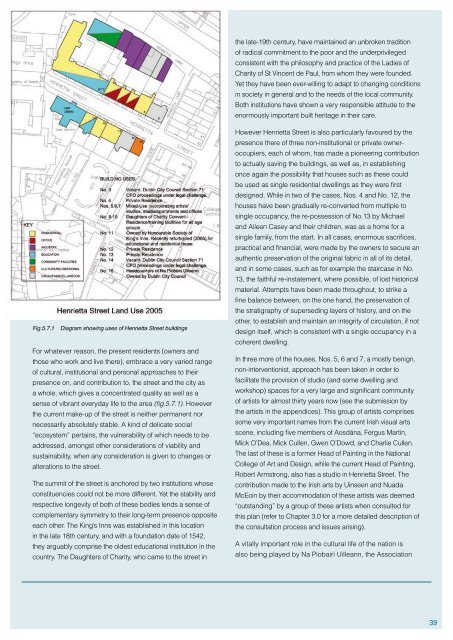Henrietta Street Conservation Plan - The Heritage Council
Henrietta Street Conservation Plan - The Heritage Council
Henrietta Street Conservation Plan - The Heritage Council
You also want an ePaper? Increase the reach of your titles
YUMPU automatically turns print PDFs into web optimized ePapers that Google loves.
the late-19th century, have maintained an unbroken tradition<br />
of radical commitment to the poor and the underprivileged<br />
consistent with the philosophy and practice of the Ladies of<br />
Charity of St Vincent de Paul, from whom they were founded.<br />
Yet they have been ever-willing to adapt to changing conditions<br />
in society in general and to the needs of the local community.<br />
Both institutions have shown a very responsible attitude to the<br />
enormously important built heritage in their care.<br />
Fig.5.7.1 Diagram showing uses of <strong>Henrietta</strong> <strong>Street</strong> buildings<br />
For whatever reason, the present residents (owners and<br />
those who work and live there), embrace a very varied range<br />
of cultural, institutional and personal approaches to their<br />
presence on, and contribution to, the street and the city as<br />
a whole, which gives a concentrated quality as well as a<br />
sense of vibrant everyday life to the area (fig.5.7.1). However<br />
the current make-up of the street is neither permanent nor<br />
necessarily absolutely stable. A kind of delicate social<br />
“ecosystem” pertains, the vulnerability of which needs to be<br />
addressed, amongst other considerations of viability and<br />
sustainability, when any consideration is given to changes or<br />
alterations to the street.<br />
<strong>The</strong> summit of the street is anchored by two institutions whose<br />
constituencies could not be more different. Yet the stability and<br />
respective longevity of both of these bodies lends a sense of<br />
complementary symmetry to their long-term presence opposite<br />
each other. <strong>The</strong> King’s Inns was established in this location<br />
in the late 18th century, and with a foundation date of 1542,<br />
they arguably comprise the oldest educational institution in the<br />
country. <strong>The</strong> Daughters of Charity, who came to the street in<br />
However <strong>Henrietta</strong> <strong>Street</strong> is also particularly favoured by the<br />
presence there of three non-institutional or private owneroccupiers,<br />
each of whom, has made a pioneering contribution<br />
to actually saving the buildings, as well as, in establishing<br />
once again the possibility that houses such as these could<br />
be used as single residential dwellings as they were first<br />
designed. While in two of the cases, Nos. 4 and No. 12, the<br />
houses have been gradually re-converted from multiple to<br />
single occupancy, the re-possession of No.13 by Michael<br />
and Aileen Casey and their children, was as a home for a<br />
single family, from the start. In all cases, enormous sacrifices,<br />
practical and financial, were made by the owners to secure an<br />
authentic preservation of the original fabric in all of its detail,<br />
and in some cases, such as for example the staircase in No.<br />
13, the faithful re-instatement, where possible, of lost historical<br />
material. Attempts have been made throughout, to strike a<br />
fine balance between, on the one hand, the preservation of<br />
the stratigraphy of superseding layers of history, and on the<br />
other, to establish and maintain an integrity of circulation, if not<br />
design itself, which is consistent with a single occupancy in a<br />
coherent dwelling.<br />
In three more of the houses, Nos. 5, 6 and 7, a mostly benign,<br />
non-interventionist, approach has been taken in order to<br />
facilitate the provision of studio (and some dwelling and<br />
workshop) spaces for a very large and significant community<br />
of artists for almost thirty years now (see the submission by<br />
the artists in the appendices). This group of artists comprises<br />
some very important names from the current Irish visual arts<br />
scene, including five members of Aosdána, Fergus Martin,<br />
Mick O’Dea, Mick Cullen, Gwen O’Dowd, and Charlie Cullen.<br />
<strong>The</strong> last of these is a former Head of Painting in the National<br />
College of Art and Design, while the current Head of Painting,<br />
Robert Armstrong, also has a studio in <strong>Henrietta</strong> <strong>Street</strong>. <strong>The</strong><br />
contribution made to the Irish arts by Uinseen and Nuada<br />
McEoin by their accommodation of these artists was deemed<br />
“outstanding” by a group of these artists when consulted for<br />
this plan (refer to Chapter 3.0 for a more detailed description of<br />
the consultation process and issues arising).<br />
A vitally important role in the cultural life of the nation is<br />
also being played by Na Píobairí Uilleann, the Association<br />
39

















